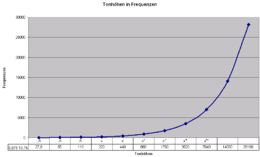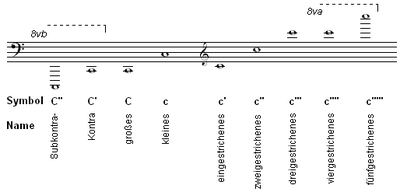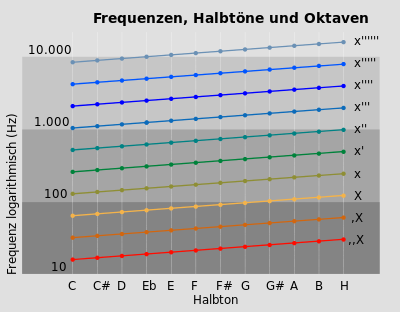Octave
![]()
This article explains the musical term. For other meanings, see Octave (disambiguation).
In music, an octave (more rarely an octave, from the Latin octava 'the eighth') is the interval between two tones that spans eight steps of a diatonic scale.
Example:Scale from f' to f'' - octave f' f'' in a row - octave f' f'' simultaneously.

Octave" can also mean the eighth note itself or an octave space (see below).
The frequency ratio of the interval octave is 2:1, which means that the upper tone has twice the number of vibrations as the lower tone.
Two notes an octave apart appear very similar, almost like a unison (prime). They are also said to have the same tonality. The reason is to be found in the actual production of tones: Tones of musical instruments are sounds composed of, among other things, the fundamental and several overtones. The first overtone of the fundamental (as a rule) has the same frequency as the fundamental octave up. It is therefore already contained in the sound of the lower tone. This makes the octave the most consonant interval after the prime, and it is easily grasped by most listeners.
The octave, unlike the other intervals, always retains the frequency ratio 2:1 even in all tempered tunings (an exception, however, is stretching when tuning the piano).
The octave is a basic interval in almost all musical cultures of the world, usually forming the basic framework for scales. Usually these scales extend over an octave space and then repeat at octave intervals (as in the Western tonal system).
Reed instruments with a conically bored tube (e.g. oboe, shawm, saxophone) overblow the first time into the octave, as do open flutes (e.g. transverse flute, recorder).
Octave is also used in the meaning "frequency ratio 2:1" in physics, acoustics and high frequency technology.
According to recent brain research, mammals have octave mapping in the auditory thalamus.

Octave of the concert pitch a (The frequencies of the octaves behave exponentially to the number of octaves)
Subdivision of the tonal space into octave spaces
The Western tonal system is usually divided into octave spaces (octave strips), each of which extends from the tone c to the next higher tone b. Each octave range has its own designation for clear naming. The notes of the lower octaves are indicated by capital letters, those of the higher octaves by lower case letters (see illustration); for each higher or lower octave a dash is added. Instead of the dashes the tone letters can be numbered (c' = c1) or, in the lower octaves, doubled ('C = C1 = CC). In the spoken form the name of the tone is preceded by the name of the octave (e.g. "capital d" for D, "bowed g" for g' ). The individual octave spaces, including the usual frequency spaces, are as follows:
- Subcontra-octave: from '''C (8.2 Hz) to '''B (the tones '''C to '''A are no longer perceived at all by the human ear, while a few people can still hear '''B (15.5 Hz) and very few can hear '''B (14.6 Hz))
- Subcontra-octave: from ''C (16.4 Hz) to ''B (tones below 16 Hz are generally no longer perceived by the human ear)
- Contra octave: from 'C (32.7 Hz) to 'B
- Great octave: from C (65.4 Hz) to B
- Small octave: from c (130.8 Hz) to b
- Dotted octave: from c' (261.6 Hz) to b' (the dotted a (a' = 440 Hz) is the standardized concert pitch)
- Two-note octave: from c'' (523.2 Hz) to b''
- Three-note octave: from c''' (1047 Hz) to h'''
- Four-note octave: from c'''' (2093 Hz) to h''''
- Five-note octave: from c''''' (4186 Hz) to h'''''
- etc. ...theoretically there is no upper limit, but in fact the hearing limit of even infants is exceeded at the latest in the eighth octave.
The range in which musical instruments play and can be heard by humans usually extends from 'C of the contra octave (double bass, contrabassoon, contrabass tuba, contrabass clarinet and contrabass trombone) up to c''''' of the five-note octave (piccolo, glockenspiel, celesta). Tones outside this range are rarely used, as they would be barely audible. The piano reaches down to the subcontra-A (''A). Larger organs usually have a 32′ stop in the pedalboard that reaches down to subcontra-C (''C).
In musical notation, in order to avoid too many auxiliary lines, notes in the very high or very low register are notated in a special way (see also transposing musical instrument): brackets with the designations 8vb (ital. ottava bassa: 'low octave') and 8va (ital. ottava alta: 'high octave') indicate that the note should sound one octave lower or higher than notated. Occasionally there are also shifts of two octaves (15ma or 15mb, ital. quindicesima alta/bassa) (see octavation). 8va or 8vb can be cancelled again with the designation loco.

The octave spaces and the notation of octaves
The octave spaces between C and c'''

Relationship between frequency, semitone and octave
Alternative designation systems
In addition to the system presented above, which is widely used in classical music theory, there are other tone name systems for the unambiguous naming of tones.
For example, a short notation was developed which, starting from the standard 88-key keyboard, counts the octaves from bottom to top, beginning with C. The contra C ('C) is the first C on the keyboard and is called C1. The five-note c (c''''') is therefore called C8. The note B is called B because the English tone names are used. The semitones are always represented as raised with ♯ regardless of their harmonic context (enharmonic confusion), so ges'' would be written as F♯5, for example.
Especially in digital notation this simple notation has become established, in tracker music programs it is mostly the only way of representation. Often, beyond the standard keyboard (A0-C8), a spectrum of C0-B9 is available, although C0, at 16.35 Hz, represents the lower limit of the normal human hearing range, and B9, at 15.80 kHz, is at the upper limit and can no longer be clearly determined tonally. Theoretically, this notation, like the classical one, can be extended in both directions as desired.
Questions and Answers
Q: What is an octave?
A: An octave is the distance between two musical notes that have the same letter name.
Q: What does "octo" mean in Latin?
A: Octo means eight in Latin.
Q: How do two notes that are an octave apart sound?
A: Two notes that are an octave apart sound very similar, almost like the same note.
Q: Why do two notes that are an octave apart sound similar?
A: The scientific reason for this is that the top note vibrates twice as fast. For example, if someone plays Middle C on a piano, a hammer hits the Middle C strings inside and makes them vibrate 256 times a second while the C an octave higher will vibrate 512 times a second.
Q: Are young children able to stretch an octave with one hand?
A: No, young children who learn the piano will not be able to stretch an octave with one hand if their hands are too small.
Q: Can most adults stretch an octave easily?
A: Yes, most adults can stretch an octave easily by playing one note with their thumb and another with their little finger.
Search within the encyclopedia